Wireless Networks Assignment: Analysis of Wireless Networks Signals
VerifiedAdded on 2022/10/09
|15
|1949
|27
Homework Assignment
AI Summary
This document presents a comprehensive solution to a wireless networks assignment. It begins with an analysis of different antenna types, including Yagi, Horn, and Cellular antennas, discussing their strengths, weaknesses, and potential for future dominance in wireless links. The solution then addresses a problem related to signal power reduction in radio and wire transmissions, completing a table with dB reduction values. Further, the assignment explores the relationship between a signal's spectrum and its bandwidth, identifies key factors affecting channel capacity, and explains how frequency division multiplexing avoids interference. It also includes calculations for a digital signalling system, explores atmospheric absorption, and discusses the advantages of parabolic reflective antennas and spread spectrum technology. Finally, the solution lists the benefits of spread spectrum and provides a detailed overview of the concepts covered, with references to relevant research papers.
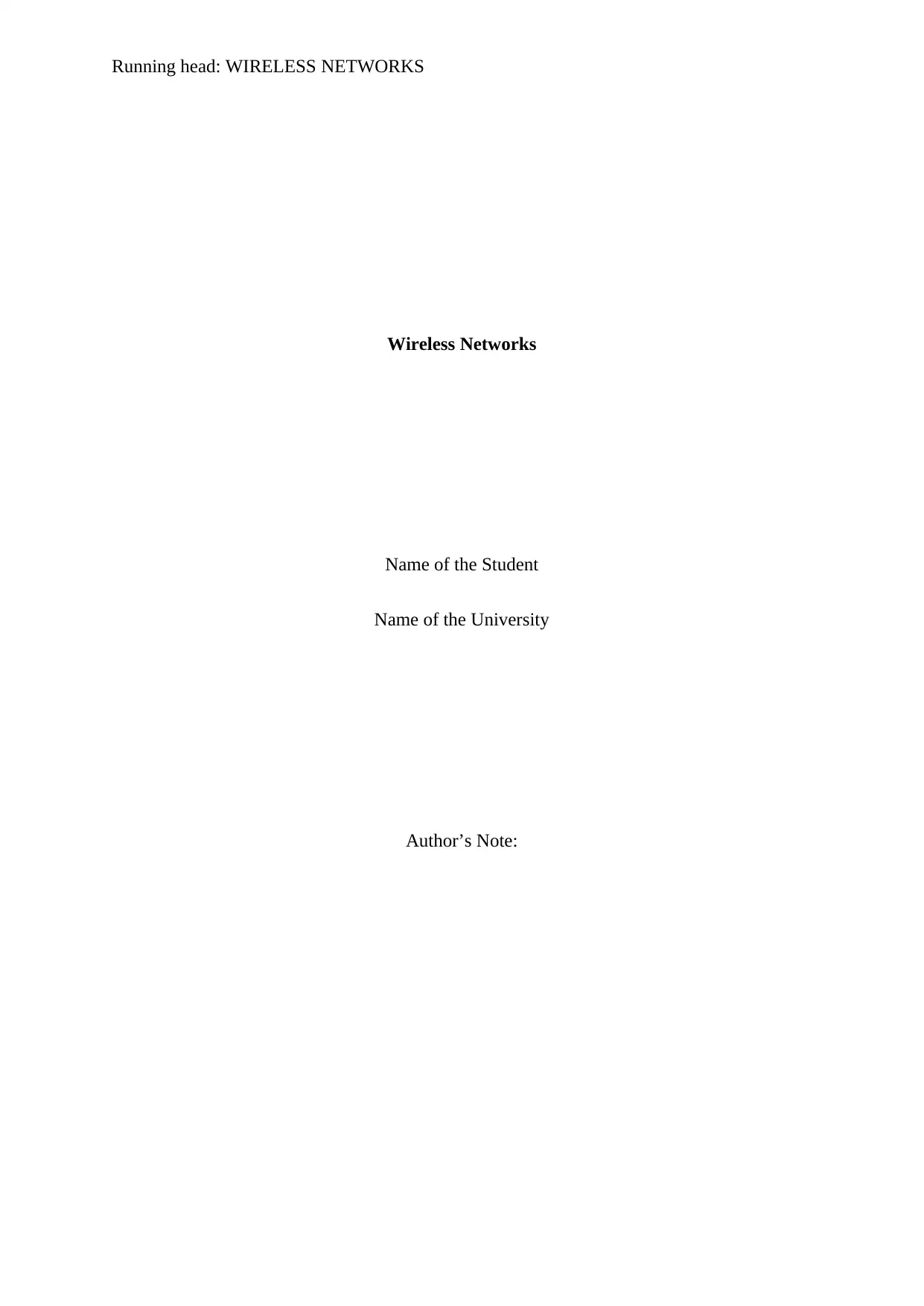
Running head: WIRELESS NETWORKS
Wireless Networks
Name of the Student
Name of the University
Author’s Note:
Wireless Networks
Name of the Student
Name of the University
Author’s Note:
Paraphrase This Document
Need a fresh take? Get an instant paraphrase of this document with our AI Paraphraser
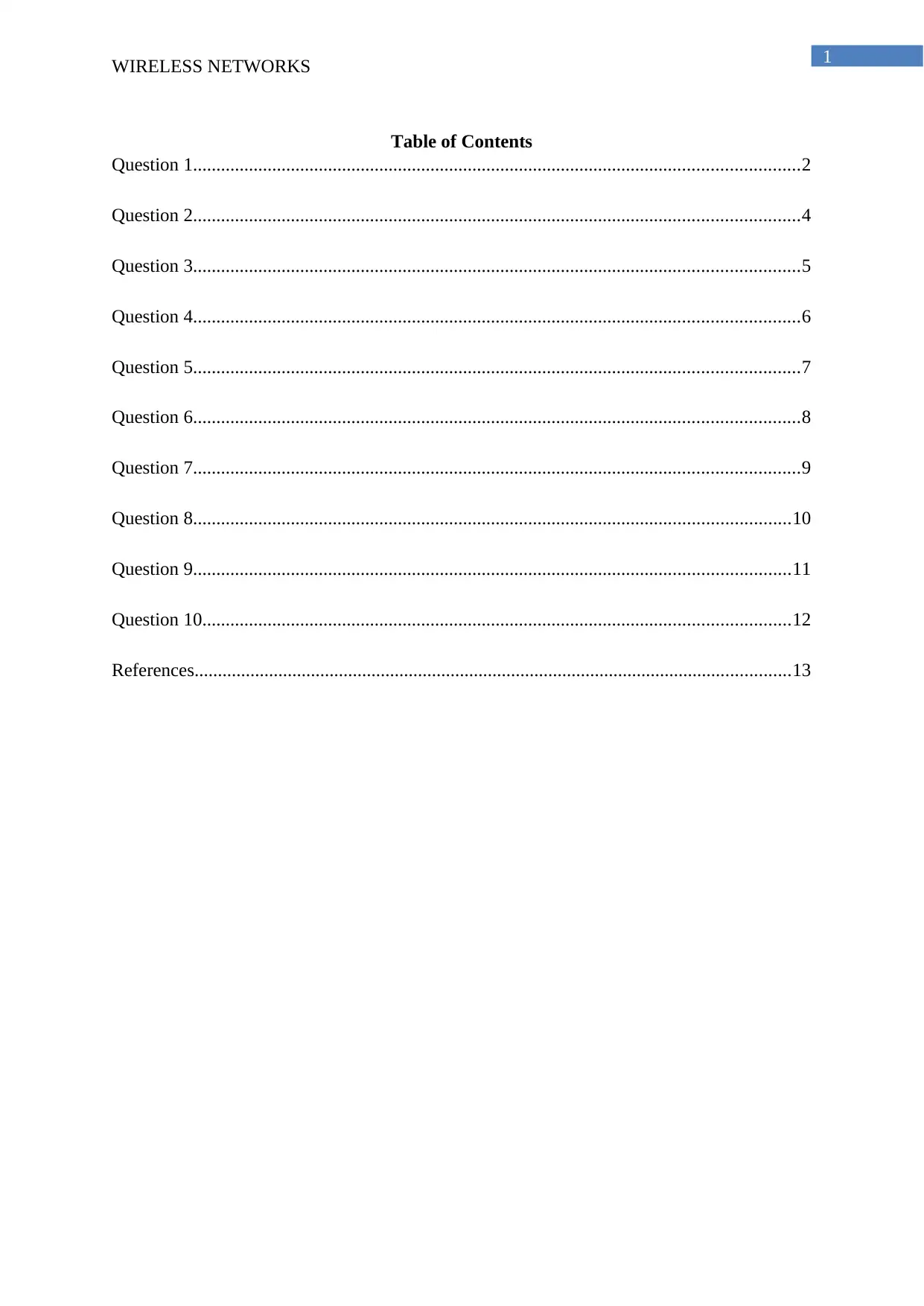
1
WIRELESS NETWORKS
Table of Contents
Question 1..................................................................................................................................2
Question 2..................................................................................................................................4
Question 3..................................................................................................................................5
Question 4..................................................................................................................................6
Question 5..................................................................................................................................7
Question 6..................................................................................................................................8
Question 7..................................................................................................................................9
Question 8................................................................................................................................10
Question 9................................................................................................................................11
Question 10..............................................................................................................................12
References................................................................................................................................13
WIRELESS NETWORKS
Table of Contents
Question 1..................................................................................................................................2
Question 2..................................................................................................................................4
Question 3..................................................................................................................................5
Question 4..................................................................................................................................6
Question 5..................................................................................................................................7
Question 6..................................................................................................................................8
Question 7..................................................................................................................................9
Question 8................................................................................................................................10
Question 9................................................................................................................................11
Question 10..............................................................................................................................12
References................................................................................................................................13
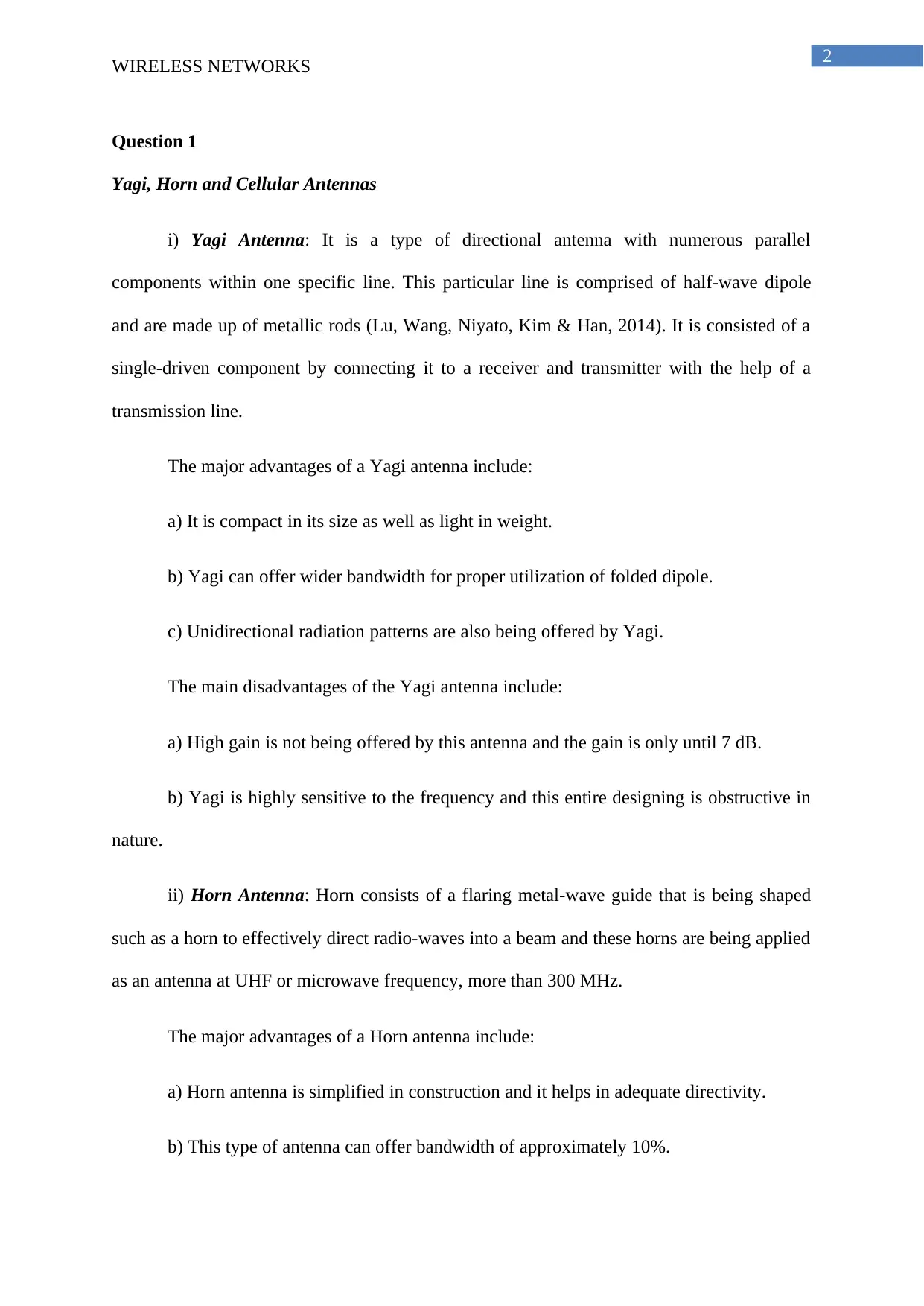
2
WIRELESS NETWORKS
Question 1
Yagi, Horn and Cellular Antennas
i) Yagi Antenna: It is a type of directional antenna with numerous parallel
components within one specific line. This particular line is comprised of half-wave dipole
and are made up of metallic rods (Lu, Wang, Niyato, Kim & Han, 2014). It is consisted of a
single-driven component by connecting it to a receiver and transmitter with the help of a
transmission line.
The major advantages of a Yagi antenna include:
a) It is compact in its size as well as light in weight.
b) Yagi can offer wider bandwidth for proper utilization of folded dipole.
c) Unidirectional radiation patterns are also being offered by Yagi.
The main disadvantages of the Yagi antenna include:
a) High gain is not being offered by this antenna and the gain is only until 7 dB.
b) Yagi is highly sensitive to the frequency and this entire designing is obstructive in
nature.
ii) Horn Antenna: Horn consists of a flaring metal-wave guide that is being shaped
such as a horn to effectively direct radio-waves into a beam and these horns are being applied
as an antenna at UHF or microwave frequency, more than 300 MHz.
The major advantages of a Horn antenna include:
a) Horn antenna is simplified in construction and it helps in adequate directivity.
b) This type of antenna can offer bandwidth of approximately 10%.
WIRELESS NETWORKS
Question 1
Yagi, Horn and Cellular Antennas
i) Yagi Antenna: It is a type of directional antenna with numerous parallel
components within one specific line. This particular line is comprised of half-wave dipole
and are made up of metallic rods (Lu, Wang, Niyato, Kim & Han, 2014). It is consisted of a
single-driven component by connecting it to a receiver and transmitter with the help of a
transmission line.
The major advantages of a Yagi antenna include:
a) It is compact in its size as well as light in weight.
b) Yagi can offer wider bandwidth for proper utilization of folded dipole.
c) Unidirectional radiation patterns are also being offered by Yagi.
The main disadvantages of the Yagi antenna include:
a) High gain is not being offered by this antenna and the gain is only until 7 dB.
b) Yagi is highly sensitive to the frequency and this entire designing is obstructive in
nature.
ii) Horn Antenna: Horn consists of a flaring metal-wave guide that is being shaped
such as a horn to effectively direct radio-waves into a beam and these horns are being applied
as an antenna at UHF or microwave frequency, more than 300 MHz.
The major advantages of a Horn antenna include:
a) Horn antenna is simplified in construction and it helps in adequate directivity.
b) This type of antenna can offer bandwidth of approximately 10%.
⊘ This is a preview!⊘
Do you want full access?
Subscribe today to unlock all pages.

Trusted by 1+ million students worldwide
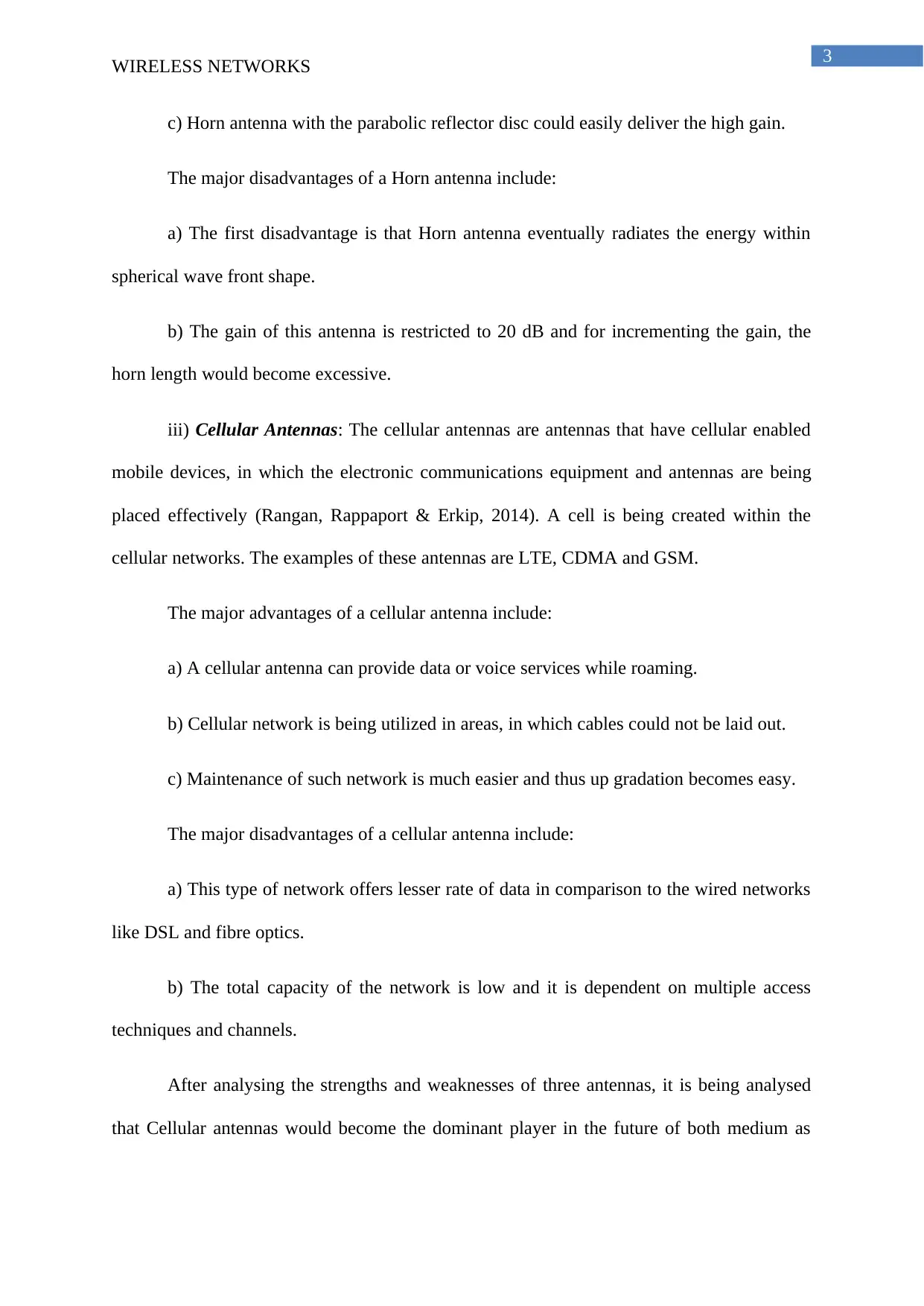
3
WIRELESS NETWORKS
c) Horn antenna with the parabolic reflector disc could easily deliver the high gain.
The major disadvantages of a Horn antenna include:
a) The first disadvantage is that Horn antenna eventually radiates the energy within
spherical wave front shape.
b) The gain of this antenna is restricted to 20 dB and for incrementing the gain, the
horn length would become excessive.
iii) Cellular Antennas: The cellular antennas are antennas that have cellular enabled
mobile devices, in which the electronic communications equipment and antennas are being
placed effectively (Rangan, Rappaport & Erkip, 2014). A cell is being created within the
cellular networks. The examples of these antennas are LTE, CDMA and GSM.
The major advantages of a cellular antenna include:
a) A cellular antenna can provide data or voice services while roaming.
b) Cellular network is being utilized in areas, in which cables could not be laid out.
c) Maintenance of such network is much easier and thus up gradation becomes easy.
The major disadvantages of a cellular antenna include:
a) This type of network offers lesser rate of data in comparison to the wired networks
like DSL and fibre optics.
b) The total capacity of the network is low and it is dependent on multiple access
techniques and channels.
After analysing the strengths and weaknesses of three antennas, it is being analysed
that Cellular antennas would become the dominant player in the future of both medium as
WIRELESS NETWORKS
c) Horn antenna with the parabolic reflector disc could easily deliver the high gain.
The major disadvantages of a Horn antenna include:
a) The first disadvantage is that Horn antenna eventually radiates the energy within
spherical wave front shape.
b) The gain of this antenna is restricted to 20 dB and for incrementing the gain, the
horn length would become excessive.
iii) Cellular Antennas: The cellular antennas are antennas that have cellular enabled
mobile devices, in which the electronic communications equipment and antennas are being
placed effectively (Rangan, Rappaport & Erkip, 2014). A cell is being created within the
cellular networks. The examples of these antennas are LTE, CDMA and GSM.
The major advantages of a cellular antenna include:
a) A cellular antenna can provide data or voice services while roaming.
b) Cellular network is being utilized in areas, in which cables could not be laid out.
c) Maintenance of such network is much easier and thus up gradation becomes easy.
The major disadvantages of a cellular antenna include:
a) This type of network offers lesser rate of data in comparison to the wired networks
like DSL and fibre optics.
b) The total capacity of the network is low and it is dependent on multiple access
techniques and channels.
After analysing the strengths and weaknesses of three antennas, it is being analysed
that Cellular antennas would become the dominant player in the future of both medium as
Paraphrase This Document
Need a fresh take? Get an instant paraphrase of this document with our AI Paraphraser

4
WIRELESS NETWORKS
well as long-distance wireless link. The main reason for such opinion is that the mobile and
fixed subscribers are being linked immediately with these networks.
WIRELESS NETWORKS
well as long-distance wireless link. The main reason for such opinion is that the mobile and
fixed subscribers are being linked immediately with these networks.
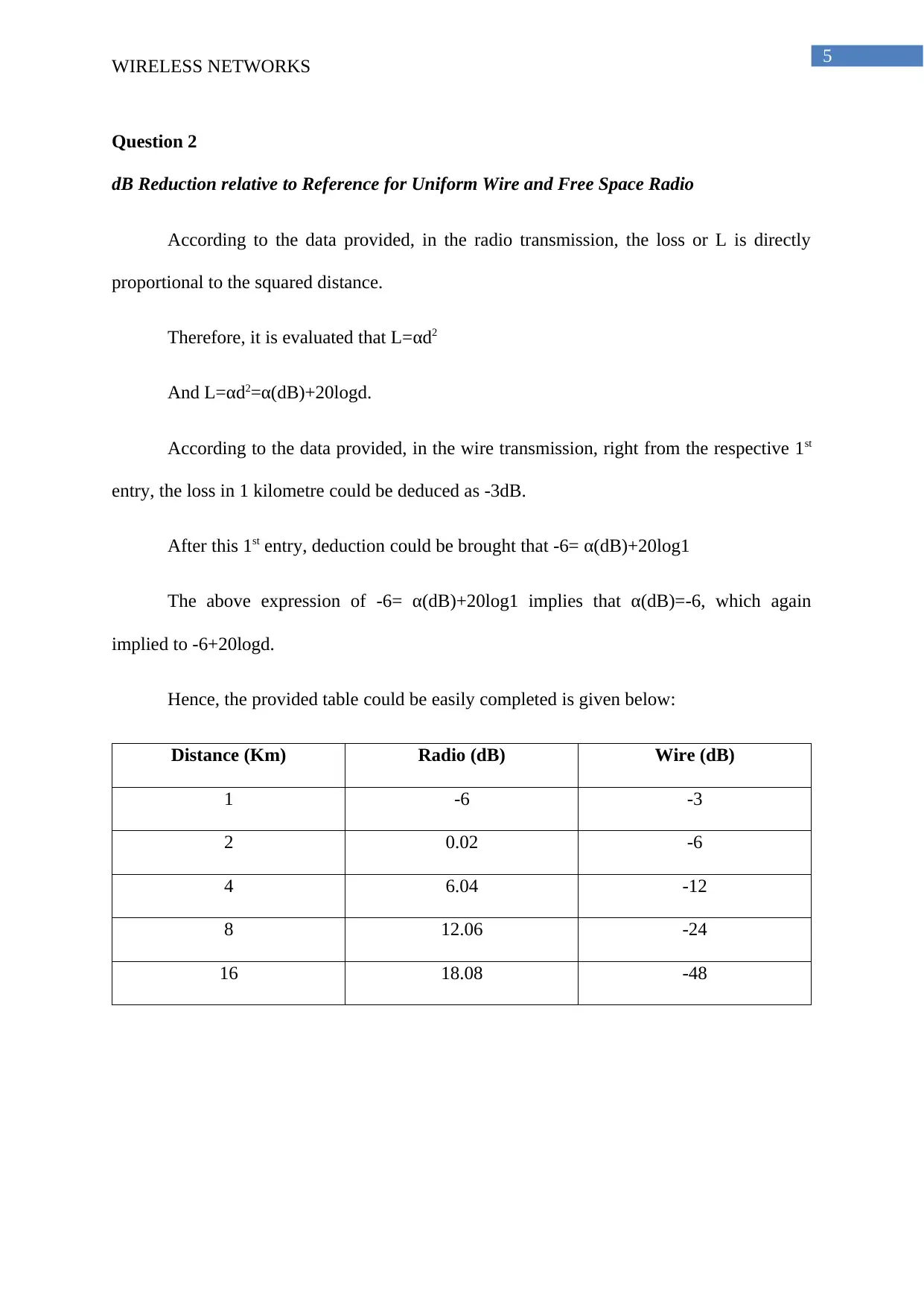
5
WIRELESS NETWORKS
Question 2
dB Reduction relative to Reference for Uniform Wire and Free Space Radio
According to the data provided, in the radio transmission, the loss or L is directly
proportional to the squared distance.
Therefore, it is evaluated that L=αd2
And L=αd2=α(dB)+20logd.
According to the data provided, in the wire transmission, right from the respective 1st
entry, the loss in 1 kilometre could be deduced as -3dB.
After this 1st entry, deduction could be brought that -6= α(dB)+20log1
The above expression of -6= α(dB)+20log1 implies that α(dB)=-6, which again
implied to -6+20logd.
Hence, the provided table could be easily completed is given below:
Distance (Km) Radio (dB) Wire (dB)
1 -6 -3
2 0.02 -6
4 6.04 -12
8 12.06 -24
16 18.08 -48
WIRELESS NETWORKS
Question 2
dB Reduction relative to Reference for Uniform Wire and Free Space Radio
According to the data provided, in the radio transmission, the loss or L is directly
proportional to the squared distance.
Therefore, it is evaluated that L=αd2
And L=αd2=α(dB)+20logd.
According to the data provided, in the wire transmission, right from the respective 1st
entry, the loss in 1 kilometre could be deduced as -3dB.
After this 1st entry, deduction could be brought that -6= α(dB)+20log1
The above expression of -6= α(dB)+20log1 implies that α(dB)=-6, which again
implied to -6+20logd.
Hence, the provided table could be easily completed is given below:
Distance (Km) Radio (dB) Wire (dB)
1 -6 -3
2 0.02 -6
4 6.04 -12
8 12.06 -24
16 18.08 -48
⊘ This is a preview!⊘
Do you want full access?
Subscribe today to unlock all pages.

Trusted by 1+ million students worldwide
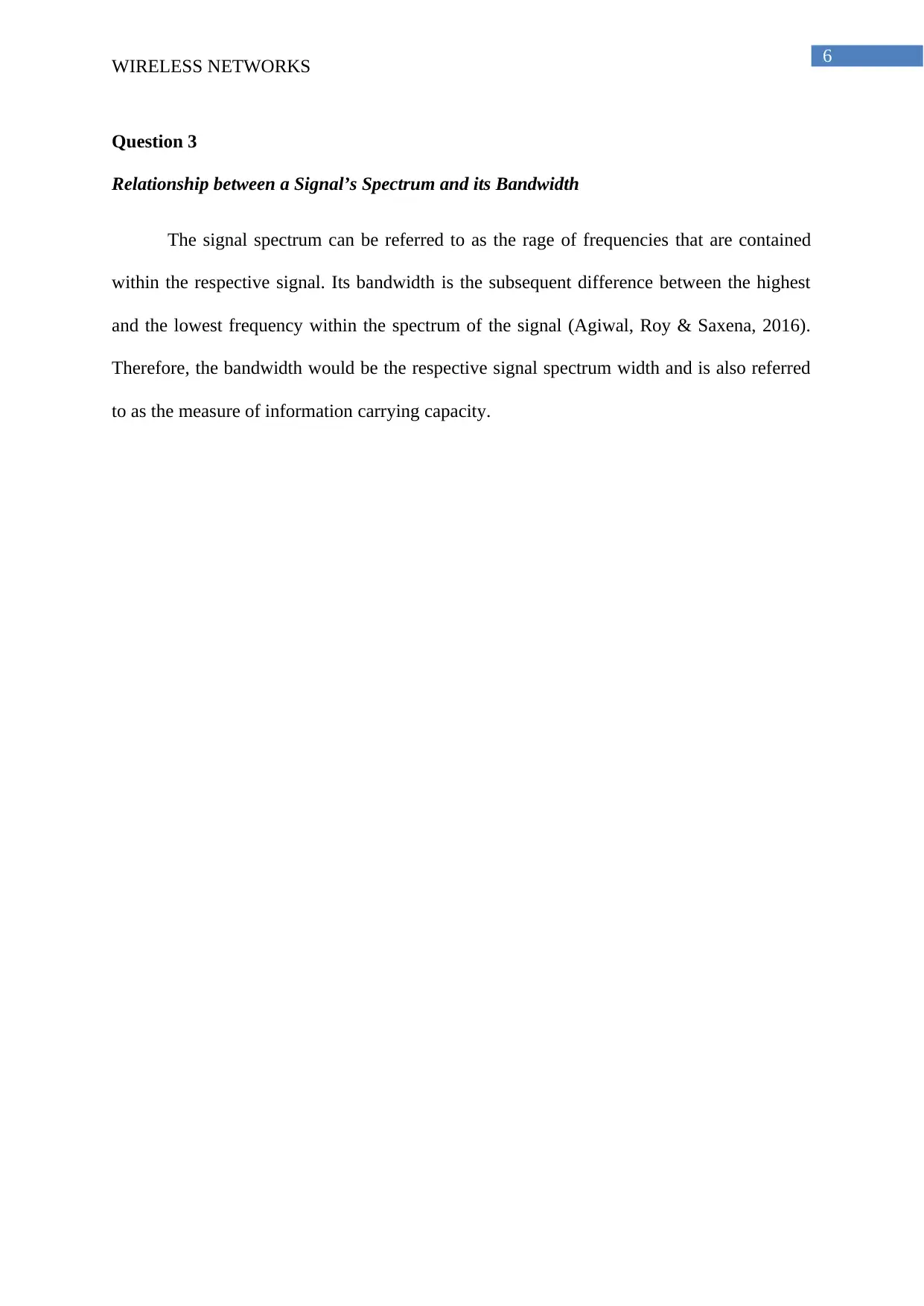
6
WIRELESS NETWORKS
Question 3
Relationship between a Signal’s Spectrum and its Bandwidth
The signal spectrum can be referred to as the rage of frequencies that are contained
within the respective signal. Its bandwidth is the subsequent difference between the highest
and the lowest frequency within the spectrum of the signal (Agiwal, Roy & Saxena, 2016).
Therefore, the bandwidth would be the respective signal spectrum width and is also referred
to as the measure of information carrying capacity.
WIRELESS NETWORKS
Question 3
Relationship between a Signal’s Spectrum and its Bandwidth
The signal spectrum can be referred to as the rage of frequencies that are contained
within the respective signal. Its bandwidth is the subsequent difference between the highest
and the lowest frequency within the spectrum of the signal (Agiwal, Roy & Saxena, 2016).
Therefore, the bandwidth would be the respective signal spectrum width and is also referred
to as the measure of information carrying capacity.
Paraphrase This Document
Need a fresh take? Get an instant paraphrase of this document with our AI Paraphraser
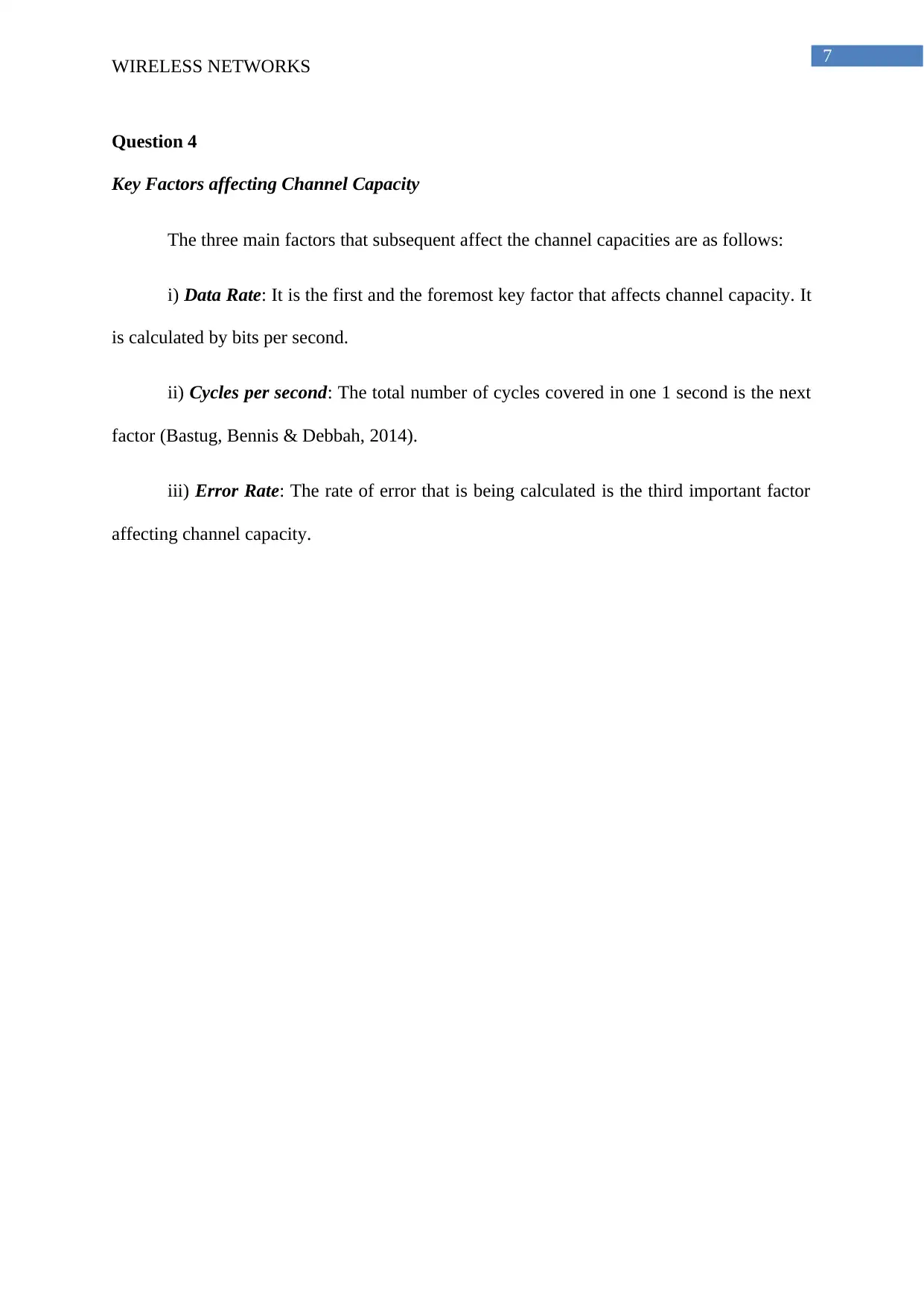
7
WIRELESS NETWORKS
Question 4
Key Factors affecting Channel Capacity
The three main factors that subsequent affect the channel capacities are as follows:
i) Data Rate: It is the first and the foremost key factor that affects channel capacity. It
is calculated by bits per second.
ii) Cycles per second: The total number of cycles covered in one 1 second is the next
factor (Bastug, Bennis & Debbah, 2014).
iii) Error Rate: The rate of error that is being calculated is the third important factor
affecting channel capacity.
WIRELESS NETWORKS
Question 4
Key Factors affecting Channel Capacity
The three main factors that subsequent affect the channel capacities are as follows:
i) Data Rate: It is the first and the foremost key factor that affects channel capacity. It
is calculated by bits per second.
ii) Cycles per second: The total number of cycles covered in one 1 second is the next
factor (Bastug, Bennis & Debbah, 2014).
iii) Error Rate: The rate of error that is being calculated is the third important factor
affecting channel capacity.
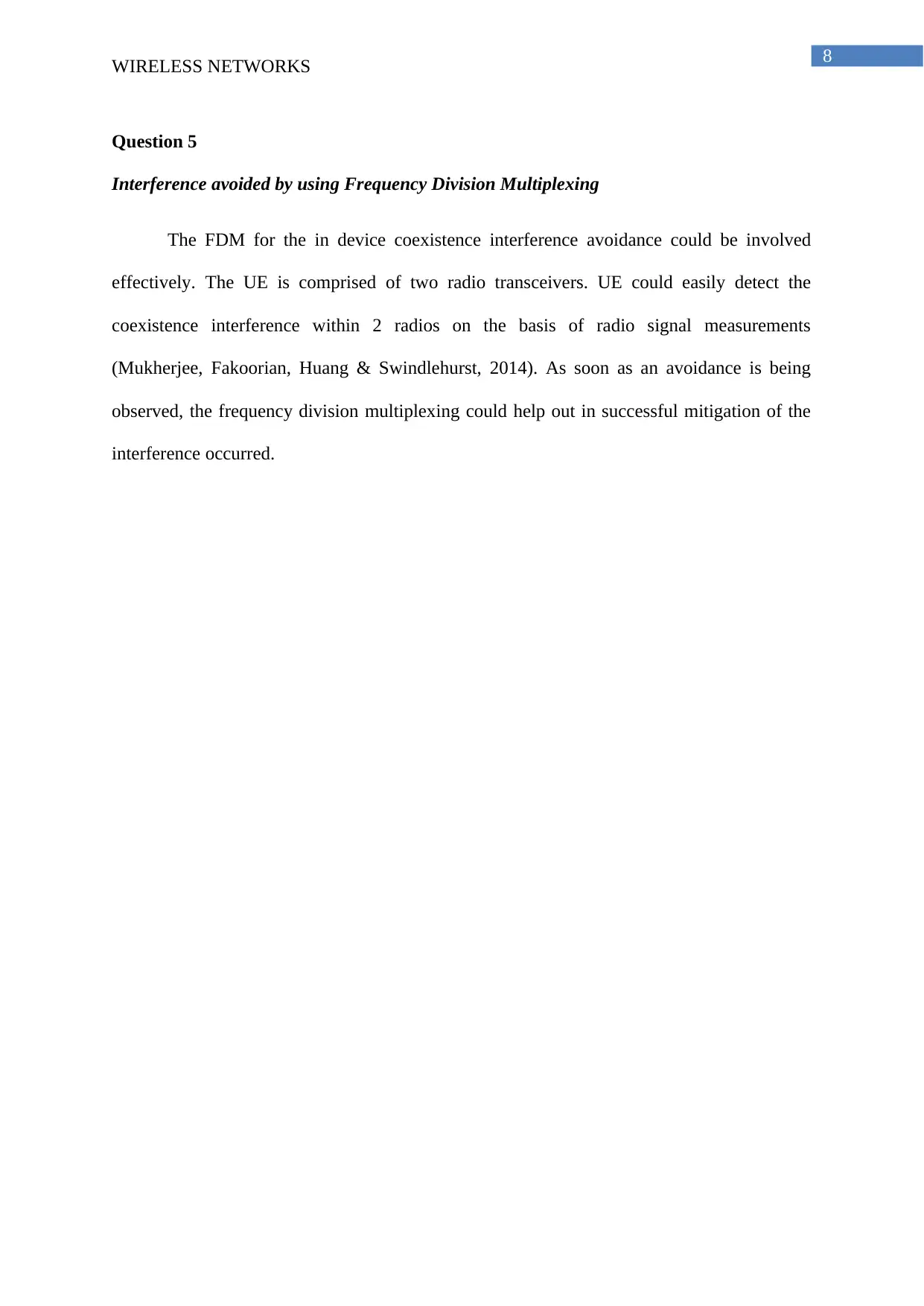
8
WIRELESS NETWORKS
Question 5
Interference avoided by using Frequency Division Multiplexing
The FDM for the in device coexistence interference avoidance could be involved
effectively. The UE is comprised of two radio transceivers. UE could easily detect the
coexistence interference within 2 radios on the basis of radio signal measurements
(Mukherjee, Fakoorian, Huang & Swindlehurst, 2014). As soon as an avoidance is being
observed, the frequency division multiplexing could help out in successful mitigation of the
interference occurred.
WIRELESS NETWORKS
Question 5
Interference avoided by using Frequency Division Multiplexing
The FDM for the in device coexistence interference avoidance could be involved
effectively. The UE is comprised of two radio transceivers. UE could easily detect the
coexistence interference within 2 radios on the basis of radio signal measurements
(Mukherjee, Fakoorian, Huang & Swindlehurst, 2014). As soon as an avoidance is being
observed, the frequency division multiplexing could help out in successful mitigation of the
interference occurred.
⊘ This is a preview!⊘
Do you want full access?
Subscribe today to unlock all pages.

Trusted by 1+ million students worldwide
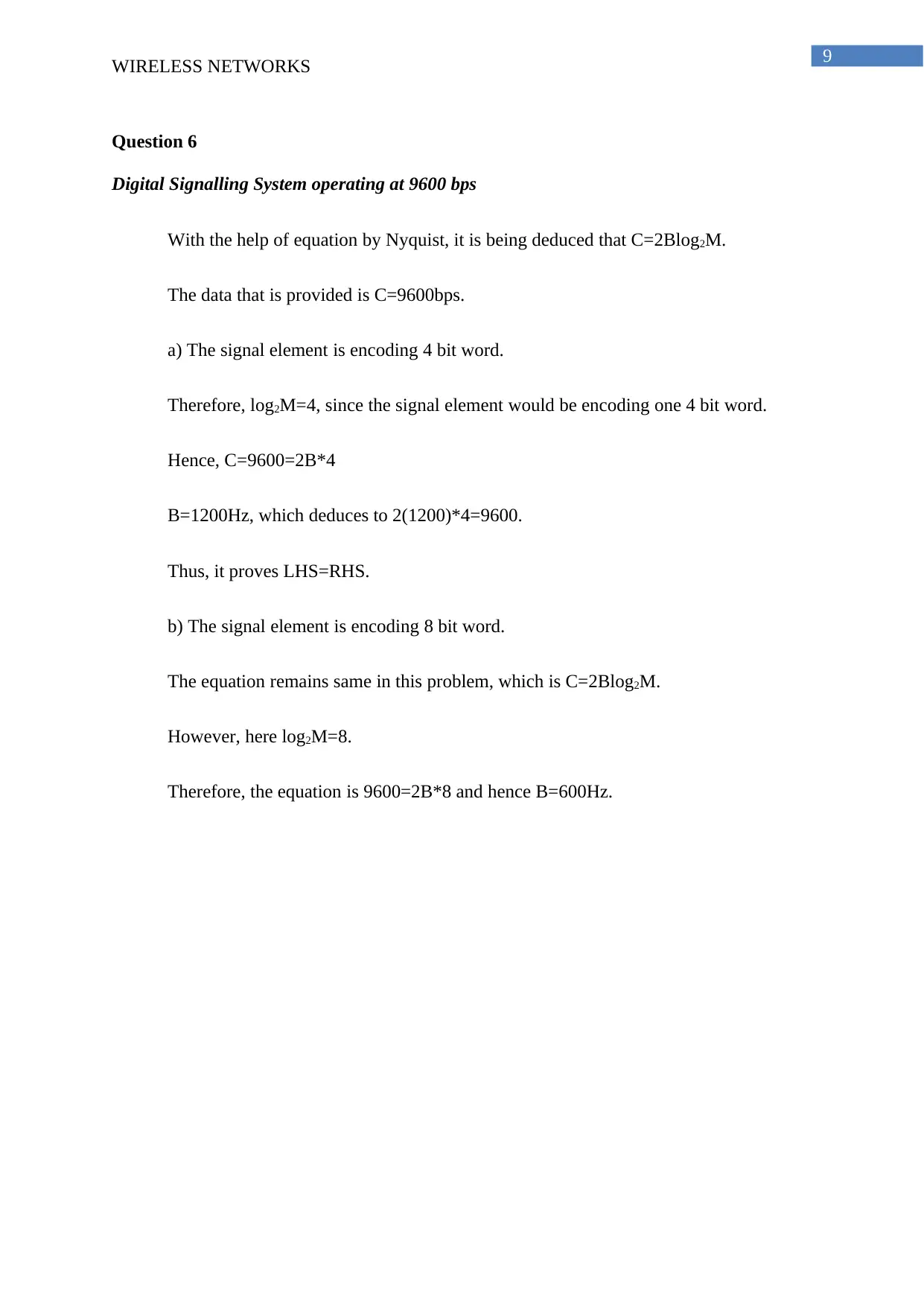
9
WIRELESS NETWORKS
Question 6
Digital Signalling System operating at 9600 bps
With the help of equation by Nyquist, it is being deduced that C=2Blog2M.
The data that is provided is C=9600bps.
a) The signal element is encoding 4 bit word.
Therefore, log2M=4, since the signal element would be encoding one 4 bit word.
Hence, C=9600=2B*4
B=1200Hz, which deduces to 2(1200)*4=9600.
Thus, it proves LHS=RHS.
b) The signal element is encoding 8 bit word.
The equation remains same in this problem, which is C=2Blog2M.
However, here log2M=8.
Therefore, the equation is 9600=2B*8 and hence B=600Hz.
WIRELESS NETWORKS
Question 6
Digital Signalling System operating at 9600 bps
With the help of equation by Nyquist, it is being deduced that C=2Blog2M.
The data that is provided is C=9600bps.
a) The signal element is encoding 4 bit word.
Therefore, log2M=4, since the signal element would be encoding one 4 bit word.
Hence, C=9600=2B*4
B=1200Hz, which deduces to 2(1200)*4=9600.
Thus, it proves LHS=RHS.
b) The signal element is encoding 8 bit word.
The equation remains same in this problem, which is C=2Blog2M.
However, here log2M=8.
Therefore, the equation is 9600=2B*8 and hence B=600Hz.
Paraphrase This Document
Need a fresh take? Get an instant paraphrase of this document with our AI Paraphraser
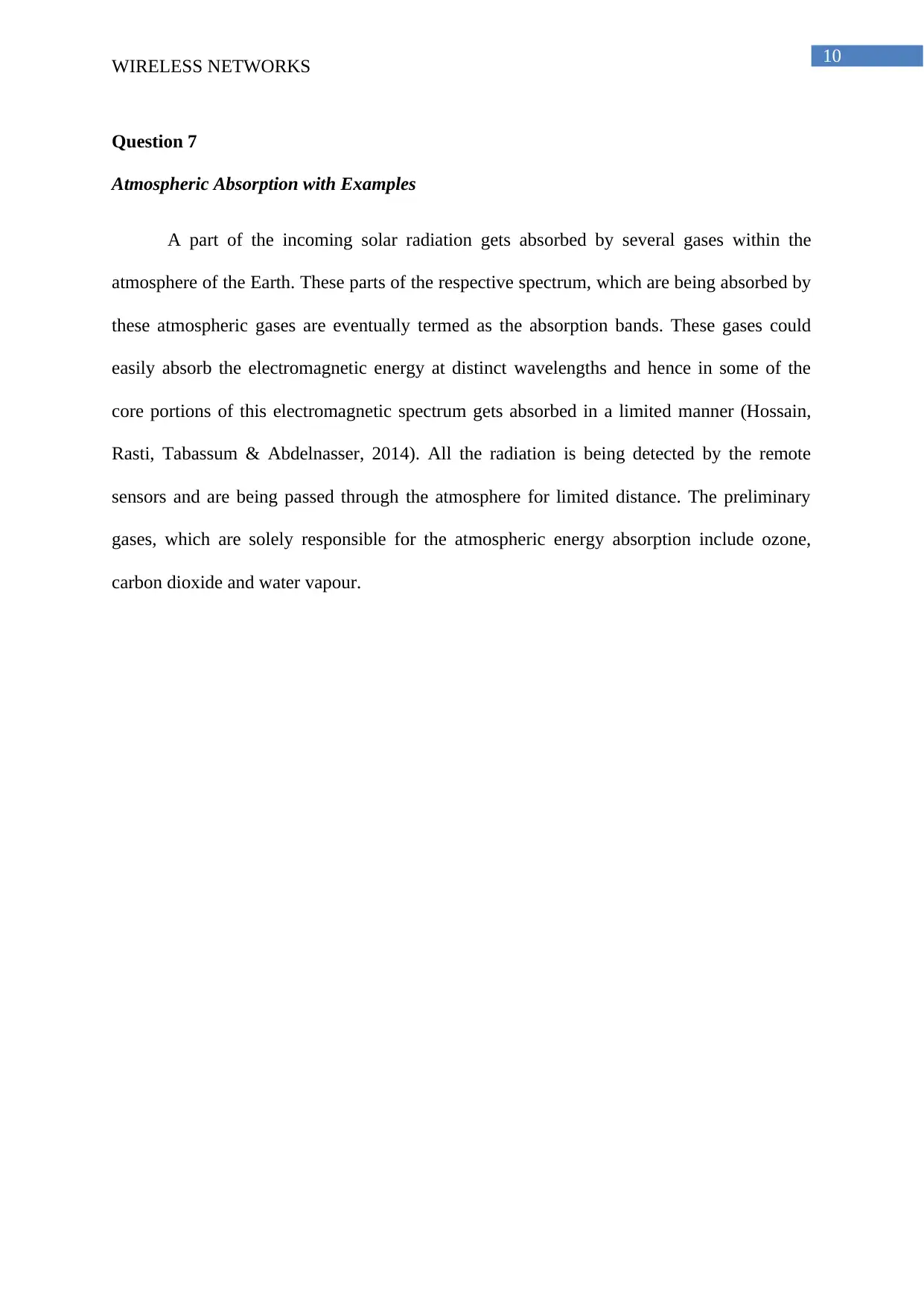
10
WIRELESS NETWORKS
Question 7
Atmospheric Absorption with Examples
A part of the incoming solar radiation gets absorbed by several gases within the
atmosphere of the Earth. These parts of the respective spectrum, which are being absorbed by
these atmospheric gases are eventually termed as the absorption bands. These gases could
easily absorb the electromagnetic energy at distinct wavelengths and hence in some of the
core portions of this electromagnetic spectrum gets absorbed in a limited manner (Hossain,
Rasti, Tabassum & Abdelnasser, 2014). All the radiation is being detected by the remote
sensors and are being passed through the atmosphere for limited distance. The preliminary
gases, which are solely responsible for the atmospheric energy absorption include ozone,
carbon dioxide and water vapour.
WIRELESS NETWORKS
Question 7
Atmospheric Absorption with Examples
A part of the incoming solar radiation gets absorbed by several gases within the
atmosphere of the Earth. These parts of the respective spectrum, which are being absorbed by
these atmospheric gases are eventually termed as the absorption bands. These gases could
easily absorb the electromagnetic energy at distinct wavelengths and hence in some of the
core portions of this electromagnetic spectrum gets absorbed in a limited manner (Hossain,
Rasti, Tabassum & Abdelnasser, 2014). All the radiation is being detected by the remote
sensors and are being passed through the atmosphere for limited distance. The preliminary
gases, which are solely responsible for the atmospheric energy absorption include ozone,
carbon dioxide and water vapour.
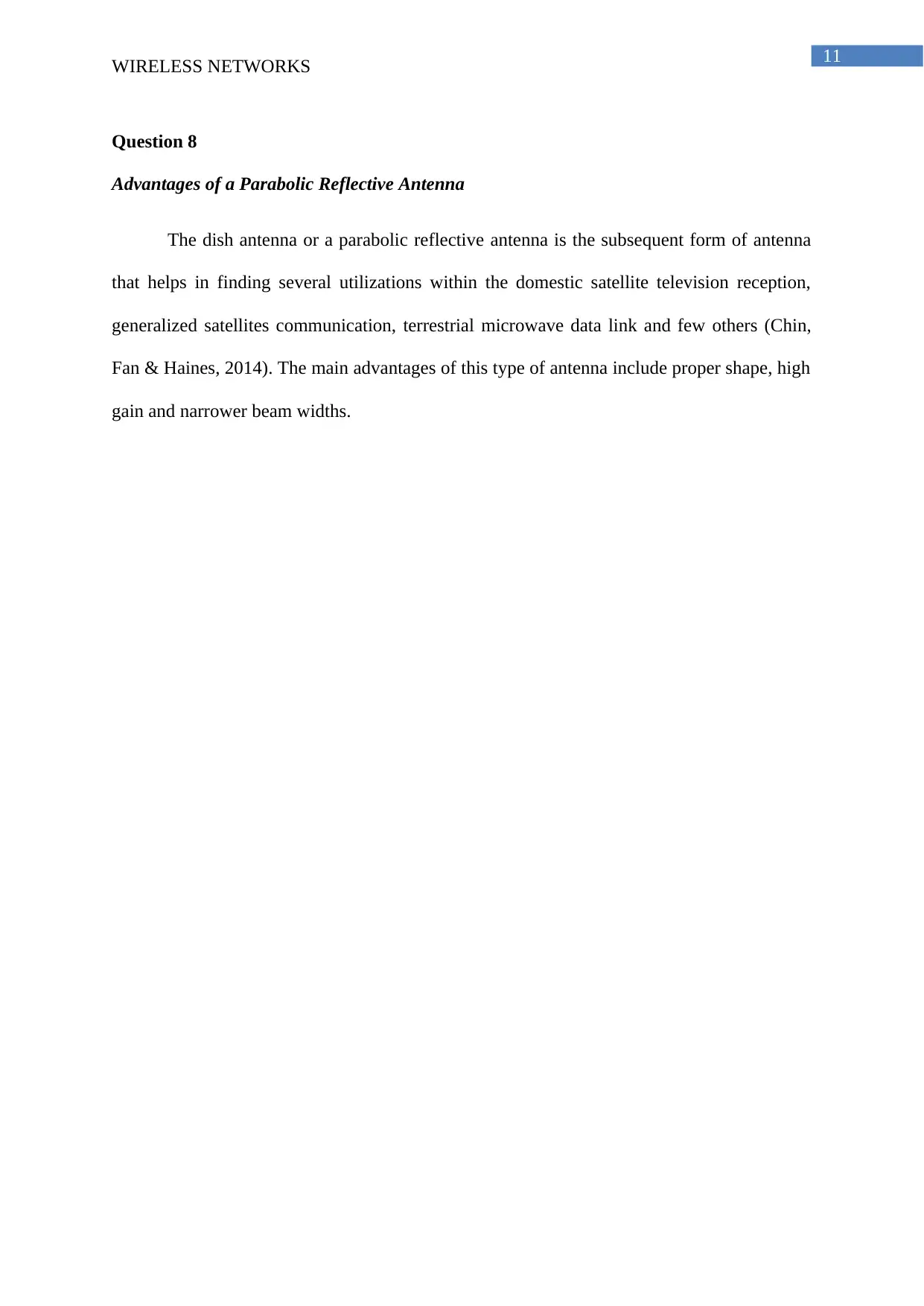
11
WIRELESS NETWORKS
Question 8
Advantages of a Parabolic Reflective Antenna
The dish antenna or a parabolic reflective antenna is the subsequent form of antenna
that helps in finding several utilizations within the domestic satellite television reception,
generalized satellites communication, terrestrial microwave data link and few others (Chin,
Fan & Haines, 2014). The main advantages of this type of antenna include proper shape, high
gain and narrower beam widths.
WIRELESS NETWORKS
Question 8
Advantages of a Parabolic Reflective Antenna
The dish antenna or a parabolic reflective antenna is the subsequent form of antenna
that helps in finding several utilizations within the domestic satellite television reception,
generalized satellites communication, terrestrial microwave data link and few others (Chin,
Fan & Haines, 2014). The main advantages of this type of antenna include proper shape, high
gain and narrower beam widths.
⊘ This is a preview!⊘
Do you want full access?
Subscribe today to unlock all pages.

Trusted by 1+ million students worldwide
1 out of 15
Related Documents
Your All-in-One AI-Powered Toolkit for Academic Success.
+13062052269
info@desklib.com
Available 24*7 on WhatsApp / Email
![[object Object]](/_next/static/media/star-bottom.7253800d.svg)
Unlock your academic potential
Copyright © 2020–2025 A2Z Services. All Rights Reserved. Developed and managed by ZUCOL.




